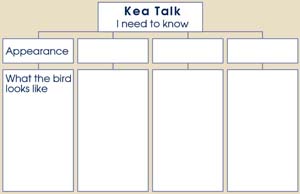|
||||||||||||||||
|
||||||||||||||||
%
responses 2009 ('05) |
||||||||||||||||
y4 |
y8 |
|||||||||||||||
 1. Write down the things you need to know so that you can talk about it. 1. Write down the things you need to know so that you can talk about it. The first one is done for you. [Click on chart to enlarge.] |
||||||||||||||||
Mentioned: |
food – what the bird eats |
45 (48) |
70 (60) |
|||||||||||||
habitat – where the bird lives |
43 (38) |
82 (70) |
||||||||||||||
conservation – how to care for
the bird and its environment |
2 (2) |
5 (2) |
||||||||||||||
breeding – how do kea reproduce |
2 (4) |
9 (12) |
||||||||||||||
habits – what behaviours do they
engage in |
21 (14) |
23 (19) |
||||||||||||||
caring for young – how do they look
after chicks |
1 (4) |
3 (4) |
||||||||||||||
anything else reasonable |
40 (51) |
54 (56) |
||||||||||||||
Made: |
appropriate use of headings
and examples |
38 (35) |
75 (67) |
|||||||||||||
| 2. At the end of your study, which things do you think you should know about keas? [List was given as below.] Tick the boxes. |
||||||||||||||||
Ticked: |
how big a kea is |
82 (83) |
87 (83) |
|||||||||||||
how many different kinds of birds
in New Zealand |
47 (45) |
30 (18) |
||||||||||||||
where the kea can be found |
84 (86) |
93 (94) |
||||||||||||||
if kea are shy birds |
65 (66) |
75 (61) |
||||||||||||||
come out only at night |
49 (98) |
34 (27) |
||||||||||||||
eat eggs of other birds |
56 (57) |
58 (65) |
||||||||||||||
where to buy kea toys |
34 (34) |
11 (9) |
||||||||||||||
how kea look after their chicks |
80 (80) |
86 (82) |
||||||||||||||
Total
score: |
5–6 |
1 (2) |
8 (5) |
|||||||||||||
4 |
15 (17) |
49 (41) |
||||||||||||||
3 |
21 (12) |
20 (20) |
||||||||||||||
2 |
21 (29) |
10 (12) |
||||||||||||||
0–1 |
42 (40) |
14 (22) |
||||||||||||||
| Subgroup Analysis [Click on charts to enlarge] : |
| Commentary: |
| Year 4 students had difficulty with this task, with many only being able to provide a minimal response. Year 8 students were much more successful, particularly in their ability to use the headings and provide examples appropriate for the headings. Girls outperformed boys, more so at year 8 than year 4. Differences by ethnicity were small to moderate. |

